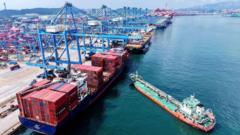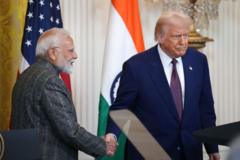Southeast Asia grapples with the implications of President Trump's tariffs on China, creating challenges for local businesses and economic prospects. Entrepreneurs fear the impact of the proposed tariffs while seeking to assert their position in global supply chains amidst growing competition from China.
Southeast Asia's Dilemma: Navigating Trump's Tariffs Amid Chinese Competition

Southeast Asia's Dilemma: Navigating Trump's Tariffs Amid Chinese Competition
As President Trump's tariffs loom, Southeast Asian nations face tough choices, caught between the US and China, impacting local economies.
Southeast Asia stands at a crossroads as US President Donald Trump's proposed tariffs pose a complex challenge for nations like Vietnam, Indonesia, and Malaysia. The tariffs, designed to target Chinese imports, have inadvertently created an opening for Southeast Asian businesses. Vietnamese entrepreneur Hao Le, who runs SHDC Electronics, is among those anxiously monitoring potential tariffs of up to 46% on Vietnamese goods, which could spell disaster for his $2 million monthly sales to the US.
When Trump enacted tariffs on China in 2016, they redirected a flood of Chinese goods toward Southeast Asia, creating both opportunities and challenges for local manufacturers. While many firms thrived by seizing newly available markets, they now find themselves vulnerable to retaliatory tariffs that threaten their burgeoning industries. Vietnam and Indonesia, both eager players in sectors such as electronics and electric vehicles, find themselves sandwiched between the urgent demands of the US and China's influential presence as a key trade partner.
Chinese President Xi Jinping recently visited Southeast Asia to reinforce economic ties, emphasizing the importance of unity against US tariffs. In response to rising tensions, Malaysia's trade minister, Tengku Zafrul Aziz, affirmed that the country would neither choose sides nor compromise its interests. Meanwhile, nations such as Thailand and Vietnam are scrambling to negotiate terms that preserve their access to the critical US market, with Thailand seeking enhanced investments to mitigate potential tariffs.
The Association of Southeast Asian Nations (ASEAN) appears reluctant to respond aggressively to Trump’s tariffs, instead, aiming to underscore their significance in the ongoing US-China trade dynamics. However, the threat of severe tariffs, particularly for countries like Cambodia, could severely disrupt already fragile economies dependent on low-cost exports to the US.
As local businesses voice concerns over the influx of competitively priced Chinese goods, protections are becoming increasingly necessary. Nations are considering measures such as tariffs on Chinese products and tightening import regulations to safeguard local industries from a sudden surge of Chinese exports redirected due to US tariffs.
The future of Southeast Asia's economies hangs in the balance, as businesses like Le's seek to adapt to rapidly changing market conditions. Entrepreneurs are observing increased inquiries from US buyers eager to diversify suppliers outside of China, reflecting a shift that could favor local industries in the region. While they attempt to carve out a market share, the ongoing geopolitical tussle presents a skillful diplomatic balancing act that will shape their economic landscape for years to come.


















